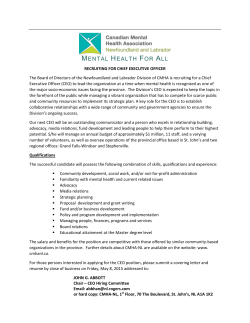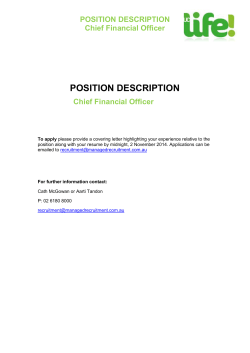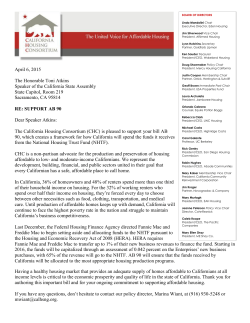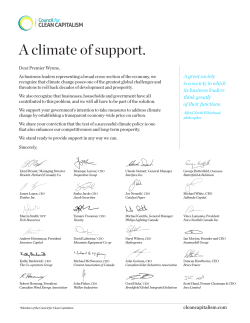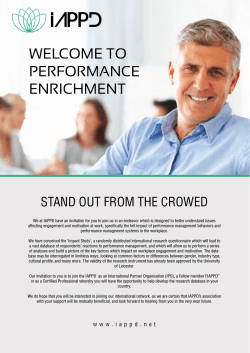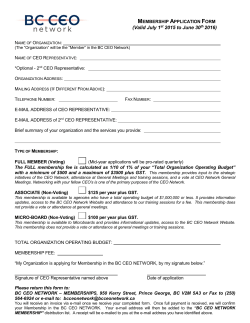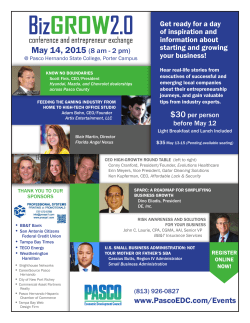
THE RELATIONSHIP BETWEEN ROLES OF CHIEF EXECUTIVE
Journal of Contemporary Management Sciences Volume 3 (6) 81-90 JCMS Publication, 2015 Journal of Contemporary Management Sciences THE RELATIONSHIP BETWEEN ROLES OF CHIEF EXECUTIVE OFFICER TOWARD FINANCIAL PERFORMANCE OF LISTED COMPANIES IN INDONESIA LITA KUSUMASARI STIE YKPN School of Business Yogyakarta, Indonesia Lkusumasari@yahoo.com ABSTRACT The purpose of this study is to analyze the relationship between roles of Chief Executive Officer (CEO) toward financial performance. Based on agency theory, CEO has role as a leader to manage company. Financial performance is the common goal setting for company. Steven Covey introduces four roles leadership. There are pioneering, alignment, empowerment, and role model. Information was gathered from 2009 to 2013 on the Best CEO award of Swa magazine, Indonesia. The best are 80 CEO then eliminated to be 31 CEO from listed companies. Swa has indexes from the best CEO on four roles and employee commitment. Those are independent variables. The financial performance taken from the listed companies is a dependent variable. The Linear regression is used. The financial performance is measured using one proxy return on assets (ROA). The data have normal distribution, no auto correlations (Durbin Watson test) and no heteroscedasticity (Glejser test). The result is CEO roles and employee commitment simultaneously is significant to financial performance. The model explained 36, 1% of financial performance based on R2. In partial model, only employee commitment is significant to financial performance. The conclusion is there is a relationship between pioneer, alignment, empowerment, role model and employee commitment to financial performance. Keywords: The roles of CEO, The best CEO, Financial Performance INTRODUCTION People believe that chief executive officer (CEO) is a reason behind successful company. Many companies are almost going bankruptcy then changing the CEO to make turn over and success. The role of CEO is so dominant toward company’s life. There are many examples of good CEOs in the worlds, including Rusdi Kirana (Lionair Indonesia), Howard Schultz (Starbucks USA), Tony Fernandez (AirAsia Malaysia) and Steve Jobs (Apple USA). Starbucks had a severe situation in 2008. They found a sharp decline sales and the stock price was going down. This was never happen in the last three decades. With the rapid expansions and global crisis, the success story of Starbucks was in question. Howard Schultz, the founder and the former CEO had already retired, but found the crisis situation Howard Schultz became CEO and cancelled the retirement. After refocusing the business, being role model, and working with the employees to commit to bounce back the success with passion then Starbucks is back to the market with more success story (Schultz and Gordon, 2012). IRC-2015 SINGAPORE Page 1 Globalization makes highly competitive world. Company is running by corporate executive. The executives are employees to the owners of the business. They have direct responsibility to their employers. As of the agent of the owners, the primary responsibility to them. The focus is raising the income (Friedman 1970). Company needs to grow and to excel. The agent has to focus to gain the income to survive. CEO will be valued with the success of financial performance of the company (earning per share, price earning ratio, return on equity, financial leverage, debt to equity, current ratio, and return on asset). The financial performance will give wealth to the owner or shareholders (Anggitasari and Mutmainah 2012). According to agency theory, the modern corporation should be governed in the interest of its shareholders and provide shareholder wealth maximization as the main criteria for decision making (Abdalla, Saleh, Kumar and Ann 2013). The other theory stated that company should governed in the interests of its shareholders and argues that the modern corporation should be governed in the interests of multiple stakeholders such as employees, suppliers, creditors and community and therefore it provides stakeholder wealth maximization as the main criteria for the decision making (Chilosi & Damiani, 2007). Henry Mitzberg (2009) identifies three roles that CEO has to do which are interpersonal roles, informational roles, and decisional roles. All those roles are collaborating to pursue the goals. Based on three roles, which role is more important than others depends on the internal and external situation of the company. Interpersonal roles need CEO to be able as figurehead, leader and also liaison. Informational roles need CEO to have ability for monitoring, disseminatoring, and as a spokesperson. The last role is decision that put a CEO to be entrepreneur, disturbance handler, allocator, and negotiator. Good management skills are still very important for the day to day, but navigating white water successfully must begin with effective leadership (Covey 2002). Strong leadership with weak management is no better and is sometimes actually worse, than reverse. The real challenge is to combine strong leadership and strong management and use each other to balance the other because leadership and management are two distictive and complementary system of action (Kotter 2001). To navigate white water, there are four roles of leadership. Those four roles are: 1. Path finding We have to understand the purpose before we can do actions. The pathfinding role helps to create a blueprint of action and ensures that plan have integrity. It is identifying a path. CEO usually divides vision into time span. Short time span is about 2-3 years, then medium span is 5 years, and long span is 10 or more years. Those dividing time span give CEO clear path to do to realize the vision on certain boundaries. In the short term, CEO will do routine and finish the partial step in big picture of vision, while in the long term CEO can set strategic things to make happen. 2. Aligning Aligning is a process to make the paves of path. Company needs to align to get the results. It is creating a technically system to work. It shares the vision and has maps to figure out that good collaboration will lead to result the vision. Management and employees need to have the same understanding on problem, challenges, and vision. Aligning will embed vision into mission. Share vision and mission will include arranging conferences, meeting, board-staff interactions, project teams, and informal get together. IRC-2015 SINGAPORE Page 2 3. Empowering People need to figure them out so that they can optimize the talent, energy and contribute to others. True empowerment yields high trust, productive communication between individual and teams, and innovative results where each member of the team feels welcome. Great leaders realize that envisioning without empowerment leads to unfulfilled vision. People have problem usually have the best ideas on how to solve it. Promoting empowerment throughout the organization will motivate them to perform beyond expectations. 4. Modeling The leader becomes the model. The team members will see that the leader walks the talk. The most effective way to lead is by example. It is also the most difficult. People demand of their leader higher standards of conduct than they ask of themselves. In essence, leaders have less behavioral freedom than those they lead. Success of the company is not solely due to roles of leadership. CEO has to make a way open to consider their leadership style create a strong commitment on the attitude of the employees toward their jobs by creating fluctuating effect on the company performance. It’s the ability of CEO to influence his subordinate by making them more satisfied, commited and in return increases productivity (Mosadeghrad, 2003). Employees’ commitment is related to the organization and concerns for the organization, and its success that is reflected by the attitude of employees (Khan, et.al, 2012). LITERATURE REVIEW Shen and Chen (2007) stated that leadership has a positive effect on team trust and team performance. Team trust also has a positive effect on team performance. Leadership styles are concern type, instructed type, and control type. Team trusts are institutional trust and relational trust. Team performances are task performance and cooperation satisfaction. Ritchie, Anthony, and Rubens (2004) found that executives with internal locus of control, high collectivism values, and analytical decision styles have greater convergence between their perceptions of performance and a financial measure. CEO who have tendencies toward formal, analytical analyses in making important decisions more accurately describe financial indicators and possibly have a greater awareness of organizational performance. Arbogast and Mirabella (2014) analyzed the relationship between CEO age, graduate education, and tenure to the performance of a company in relation to its percentage change in revenue per year. The results indicated a strong relationship between a company’s change in revenue and CEO age. Gottesman and Morey (2010) found that no significant evidence that the type of selectivity of the education of the CEO is related to firm financial performance. Firms managed by CEO with MBA perform no differently than firms with CEO who hold non-liberal arts undergraduate degree, law degree, or liberal art undergraduate degree. Another finding is firm runs by CEO from more selective school perform no better than firm run by CEO from less selective school. IRC-2015 SINGAPORE Page 3 Tan, Chng, and Tan (2001) found that CEO ownership and firm performance are jointly determined. Firm performance affects CEO ownership positively and in turn CEO ownership has a positive effect on firm performance. Firm managed by founder CEOs have better performance and that the CEO duality structure is beneficial in a turbulence environment. Guo (2013) found that there is flexibility between CEO compensation and firm performance to some extent, but it is lower, and there is no significant relation between the flexibility and future performance. Frymand and Jenter (2010) found that both managerial power and competitive market forces are important determinants of CEO pay. Khan, et.al. (2012) stated that employees’s organization commitment strongly mediated the process impact of leadership style on the organization performance. Feuss, et.al (2004) stated that leadership behavior and organization factors mirorring high-involvement work systems are strongly associated not only with employee and customer satisfaction, but also with important business outcomes, such as service quality, cost, and financial performance. Employee’s industry-occupation specific relative wage is an important factor influencing employee attitudes towards the workplace. Other factors influencing employee commitment and loyalty are age and tenure. Workplaces may be able to exert some influence over the commitment and loyalty of its workforce, which in turn, may affect workplace performance (Brown, Mc Nabb, and Taylor, 2007). RESEARCH OBJECTIVES The purpose of this study is to analyze the relationship between roles on Chief Executive Officer (CEO) toward financial performance. The result of this study is intended to help gain insight into the impact roles of CEO (pathfinding, aligning, empowering, and modeling) and also employee commitment may have on financial performance of the company. Hence the hypotheses can be stated as follows: Null Hypothesis (Ho): There is no relationship between financial performance and the following variables: (a) pathfinding of CEO, (b) aligning of CEO, (c) empowering of CEO, (d) modeling of CEO and (e) commitment of the employees in the financial performance (ROA) of the company per year. Alternative Hypothesis (HA): There is a relationship between financial performance and the following variables: (a) pathfinding of CEO, (b) aligning of CEO, (c) empowering of CEO, (d) modeling of CEO and (e) commitment of the employees in the financial performance (ROA) of the company per year. METHODOLOGY Data is taken from the CEO index for variables (pathfinding, aligning, empowering, modeling) and commitment of the employee provided by Swa Magazine from year 2009 – 2013. The Swa Magazine selects the best CEO every year. The committee of Swa gathers 300 CEOs as candidates for the Best CEO, and then sorts to be 100 CEO and choose 30 CEO to be surveyed and interviewed. Finally the Swa announces the best CEO every year, as follows: a. The best CEO for 2009 = 10 CEOs b. The best CEO for 2010 = 27 CEOs IRC-2015 SINGAPORE Page 4 c. The best CEO for 2011 = 27 CEOs d. The best CEO for 2013 = 16 CEOs Total there are 80 the best CEO. Any CEO is not from listed company is eliminated since we cannot find the financial report. After the process of elimination there are 31 CEOs for the sample of this study. Return on Asset (ROA) is used as proxy for financial performance. The ROA data are taken from financial report of the listed company from 2009 – 2013 from Investor magazine. DISCUSSION Using SPSS, a multiple Linear Regression analysis is developed to create forecasting model to predict a company financial performance and CEO roles and employee commitment. NORMALITY TEST Normality test is used to know whether the data model distributed normally. The result is the skewness ratio is 0.339 and the kurtosis ratio is 0.521 (see figure 1). Those ratio then divided by standard error to find out the result. The skewness is = The kurtosis is = -0.339 : 0.421 = -0.805 0.521 : 0.821 = 0.634 The skewness and the kurtosis are -0.805 and 0.634 and are between -2 and 2. The distribution data is normal based on the result Figure 1 Descriptive Statistics N Skewness Kurtosis Std. Unstandardized Residual Valid N (listwise) Statistic Statistic 31 -,339 Error ,421 Std. Statistic ,521 Error ,821 31 AUTO CORRELATION TEST To test auto correlation, we are using Durbin-Watson (DW) test. The result for this test as follows: Figure 2 Model Summary (b) IRC-2015 SINGAPORE Page 5 Std. Error Mo R del R 1 a Adjusted of Square ,601(a) R Square ,361 the Durbin- Estimate ,233 Watson ,88413 2,423 Predictors: (Constant), LNCommitment, LNRoleModel100, LNEmpowerment100, LNAlignment100, LNPioneer100 b Dependent Variable: LNROA The Durbin Watson is 2,423 with independent variables are 5 (n=5) and data are 31 with 5% reliability rate (see figure 2). Finding the value in the table for Durbin Watson is dL 1.090 and dU is 1.825 (Gujarati and Porter 2009). Based on the result we figure out that dL = 4 – 1.090 = 2.91 dU = 4 – 1.825 = 2.175 Durbin Watson is 2.423 The result is 2.175 < 2.423 < 2.91 so we make conclusion that the model is no auto correlation. HETEROSCEDASTICITY TEST The Glejser test is used to test the heteroscedasticity. We will look at the scatter plot and see the residual whether has a certain pattern or not. From the result is found that there is no heteroscedasticity because all independent variables are not significant on alpha 5% (see t column in figure 3). Figure 3: Coefficients(a) Unstandardized Coefficients Mo Standardize d Coefficients T Std. del B 1 Error (Constant) -2,343 ,479 LNPioneer100 -10,006 14,762 LNAlignment100 -7,359 Sig. Std. Beta B Error -4,893 ,000 -,638 -,678 ,504 11,640 -,464 -,632 ,533 -6,362 8,634 -,374 -,737 ,468 LNRoleModel100 14,733 12,673 ,913 1,163 ,256 LNCommitment 15,073 4,752 ,961 3,172 ,004 LNEmpowerment1 00 a Dependent Variable: LNROA IRC-2015 SINGAPORE Page 6 REGRESSION ANALYSIS Using multiple linear regression analysis, the model shows a strong correlation 0.601 with R square 0.361 (see figure 2). From the ANOVA table is shown that this model is significant at 0.037 (see figure 4). Figure 4 ANOVA(b) Mo Sum of del Squares 1 Regressio Df Square 11,049 5 2,210 Residual 19,542 25 ,782 Total 30,591 30 n a Mean F Sig. 2,827 ,037(a) Predictors: (Constant), LNCommitment, LNRoleModel100, LNEmpowerment100, LNAlignment100, LNPioneer100 b Dependent Variable: LNROA Although the model is significant but there are some non-significant variables as shown on coefficients table as seen in figure 3. The significant variable is only commitment, while other variables are not significant. The correlation matrix shows that the Return on Asset (ROA) as proxy of financial performance is weakly correlated with almost all variables tested (except employee commitment), but the combination of all those variables gives fairly results because is significant. CONCLUSION The roles of CEO (pioneer, alignment, empowerment, and role model) and also employees’ commitment are significant to return of assets. The company that wants to be success or grow needs to explore the roles of CEO and employees’ commitment. The CEO and the employees are agents for change. To make collaboration and work in the same vision will put company in the right track of the success financially. Based on the results above, it can be concluded that employees’ commitment has impact to the return on assets (ROA). Employees will look after the company because the wealth of the company may impact them directly or indirectly. Employees may commit to the success for the company with the expecting of raising salary, bonus, or others thing. It may that success company will secure their job. The roles of the CEO that are pioneer, alignment, empowerment, and role model are not significant as alone variable, but as a whole package than it is significant. A CEO that is so good in pioneer without alignment and role model to other than it will just be a good idea without success execution. Good alignment without vision will be left behind for the competitive change in the industry. Empowerment without alignment will not be able to execute. Role model will make people believe that we are walking the words. As whole package to be success, CEO needs to IRC-2015 SINGAPORE Page 7 explore all the roles and hand to hand with employees to pursue the vision. Khan, et, al. (2012) showed the leadership style have an impact on organization performance but in the presence of the organization’s commitment this relationship get boosted up is supported by our result. The model can only explain 36.1% of the impact between CEO roles and employees’ commitment to financial performance. Thus still many factors that influence financial performance still need more to explore and study. Arbogast and Mirabella (2014) analyze the relationship between CEO age, graduate education, and tenure to the performance of a company in relation to its percentage change in revenue per year found that only CEO age that has strong relationship with 55,1% R square. Hayes and Schaefer (2000) stated that there is positive relationship between CEO incentives and future stock price performance. While pay cannot cause performance then firm that pay their CEO the highest tend to be firms that have recently experienced high operating performance relative to their competitors (Core et.al, 1999). RECOMMENDATIONS The best CEOs from listed companies are employed in this study. If this research further developed in the future, a more random sample of CEOs probably should be employed. The CEO may be taken from more varied group of companies or stratified on revenue size to controlling the samples. Obtaining historical data in the public domain are other issues. Future research should probably use the solicitation of data directly from corporations. The time span of the years may be expandable not only four years observation but more. Firm performance is not only ROA but could be employed the other parameter such as return on equity (ROE), market to book value or labour productivity. Arbogast and Mirabella (2014) are using percentage change in revenue per year as performance of a company. It may use another roles or characteristics to differentiate between leaders and CEOs. The aspects of study could be personality, attitude toward goals, relations with others, and sense of self (Zaleznik 1992). The other aspects could be vision vs. planning, aligning vs. organizing, and motivating vs. controlling and problem solving (Kotter 2001). IRC-2015 SINGAPORE Page 8 REFERENCES 1- Abdalla, R. M., Saleh, A., Kumar, N., and Ann, J. H. (2013). The evaluation of chief executive officer performance: A stakeholder theory perspective. www.wbiconpro.com/325-Rezgala.pdf. 2- Anggitasari, N., and Mutmainah, S. (2012). The effect of financial performance to the value company toward disclosure corporate social responsibility and good corporate governance structure as moderate variable”. Diponegoro Journal of Accounting, 1 (2), 1-15. 3- Arbogast, G., and Mirabella, J. (2014). Predicting firm performance as a function of CEO and economic factors. The Journal of American Academy of Business, Cambridge, 19 (2), 96-101. 4- Brown, S., McNabb, R, and Taylor, K. (2007)/ Firm performance, worker commitment and loyalty. Working Paper. Department of Economics, University of Sheffield, ISSN 1749-8368. 5- Chilosi, A. and Damiani, M. (2007). Stakeholders vs shareholders in corporate governance, The Icfai Journal of Corporate Governance, VI, 7-45. 6- Core, J., Holthausen, R., and Larcker, D. (1999). Corporate governance, chief executive officer compensation, and firm performance. Journal of Financial Economics, 51, 371-406. 7- Covey, S.F. (2002). Three roles of the leader in the new paradigm in F. Hasselbein, R. Backhard, and M. Goldsmith (eds), The leader of the future: New visions, strategies, and practices for the next era. 8- Feuss, W.J., Harmon, J., Wirtenberg, J., and Wides, J. (2004). Linking employees, customers, and financial performance in organizations. The Journal of Cost Management, 18 (1), 1-22. 9- Friedman, M. (1970). The social responsibility is to increase profit. New York Times Magazine, p. 32-33. 10- Frydman, C. & Jenter, D. (2010). CEO compensation. Annual Review of Financial Economics, 2(1), 75-102. 11- Gottesman, A.A., and Morey, M.R. (2010). CEO educational background and firm financial performance. Journal of Applied Finance, 2, 70-82. 12- Gujarati, D.N., and Porter, D.C. (2009). Basic Econometrics. Mc. Graw Hill International Edition. 5th Edition. 13- Guo, L. (2013). Does CEO compensation stimulate firm performance effectively in China? Journal of Applied Sciences, 13 (19), 3941-3944. 14- Hayes, R. And Schaefer, S. (2000). Implicit contracts and the explanatory power of top executive compensation for future performance. Journal of Economics, 31, 279-293. 15- Investor. (2009). 100 top emiten 2009: Menguji daya tahan emiten. Ed. Mei, 31-84. 16- Investor. (2010). 100 top emiten 2010: Pemeringkatan emiten 2010”. Ed Mei. IRC-2015 SINGAPORE Page 9 17- Investor. (2011). 100 top emiten 2011: tak ada toleransi bagi yang rugi. Ed Mei, 41-86. 18- Investor (2012). 100 top emiten 2012: stamina emiten masih oke. Ed Mei. 19- Investor (2013). 100 top emiten 2013: Perlunya menjaga sustainability. EdMei. 20- Khan, V., Hafeez, M.H., Rizvi, S.M.H., Hasnain, A., and Mariam, A. (2012). Relationship of leadership styles, employees commitment and organization performance (A study on customer support representatives. European Journal of Economics, Finance and Administrative Sciences, 49, 133-143. 21- Kotter, J.P. (2001). What leaders really do. Harvard Business Review, Ed Dec, 85-96. 22- Mitzberg, H. (2009). Managing. Berrett-Koehler Publisher, Inc. San Francisco, California. 23- Mosadeghrad, A.M. (2003). The role of participative management (suggestion system) in hospital effectiveness and efficiency. Research in Medical Sciences, 8 (3), 85-96. 24- Richie, W.J., Anthony, P.A., and Rubens, A.J. (2004). Individual executive characteristics: Explaining the divergence between perceptual and financial measures in nonprofit organizations. Journal of Business Ethics, 53, 267-281. 25- Schultz, H., and Gordon, J. (2012). Onward. Jakarta, Gramedia Pustaka Utama. 26- Shen, M.J., and Chen, M.C. (2007). The relationship of leadership, team trust and team performance: A comparison of the service and manufacturing industries. Social Behavior and Personality, 35(5), 643-657. 27- Swa (2009). CEO hebat 2009. 18/XXV, 28-38. 28- Swa (2010). Mereka yang Terbaik. 23/XXVI, 24-34. 29- Swa (2012). CEO terbaik 2011: Mereka yang berakar kuat dan mengayomi. 01/XXVIII. 30- Swa (2013). Indonesia best CEO 2013 and future business leader. 10/XXIX. 31- Tan, R.S.K., Chng, P.L., and Tan, T.W. (2001). CEO share ownership and firm value. Asia Pacific Journal of Management, 18 (3), 355-371. 32- Zaleznik, A. (1992). Managers and leaders: Are they different? Harvard Business Review. March-April, 2-12. IRC-2015 SINGAPORE Page 10
© Copyright 2025
